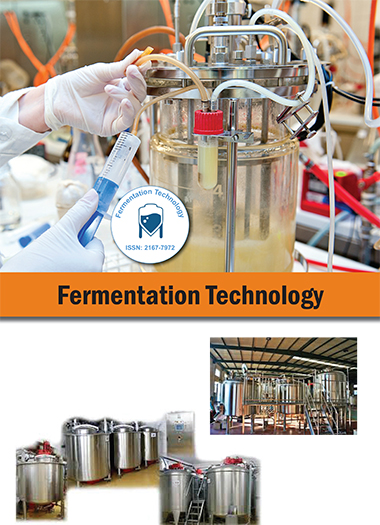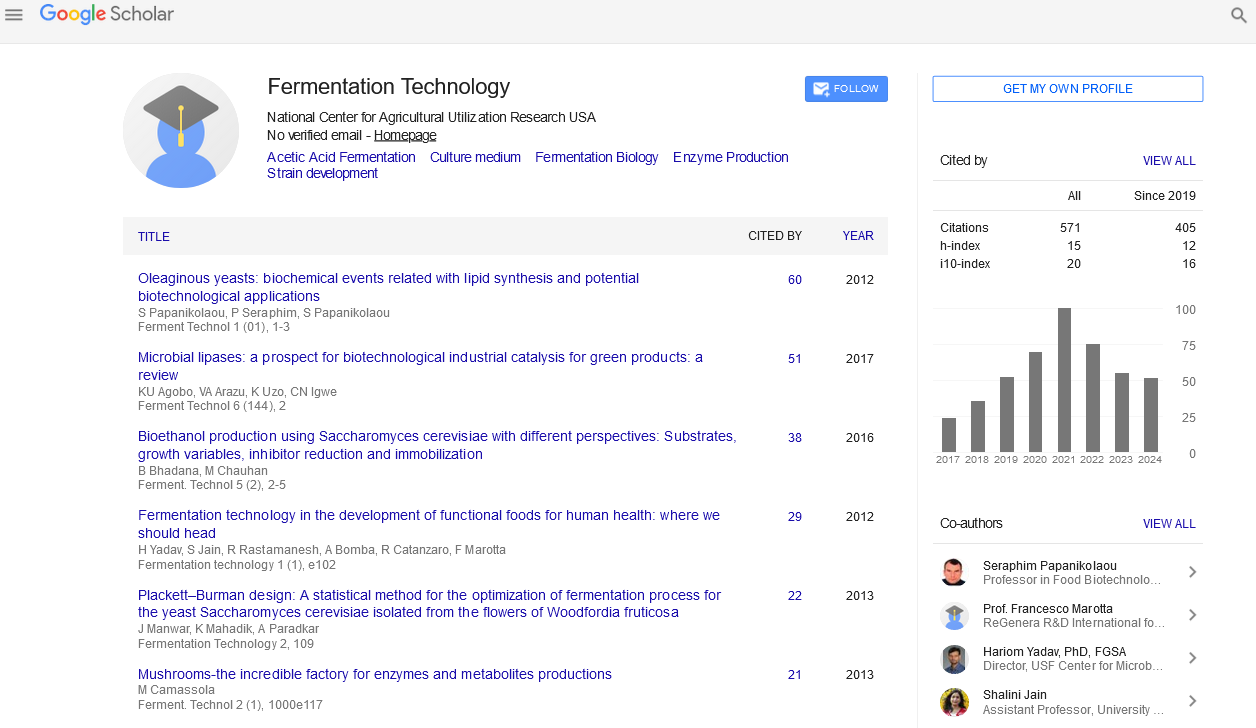Indexed In
- Open J Gate
- Genamics JournalSeek
- Access to Global Online Research in Agriculture (AGORA)
- RefSeek
- Hamdard University
- EBSCO A-Z
- OCLC- WorldCat
- Publons
Useful Links
Share This Page
Journal Flyer

Open Access Journals
- Agri and Aquaculture
- Biochemistry
- Bioinformatics & Systems Biology
- Business & Management
- Chemistry
- Clinical Sciences
- Engineering
- Food & Nutrition
- General Science
- Genetics & Molecular Biology
- Immunology & Microbiology
- Medical Sciences
- Neuroscience & Psychology
- Nursing & Health Care
- Pharmaceutical Sciences
Perspective - (2023) Volume 12, Issue 1
Biochemistry Involved in Dadawa Fermentation
Amelia Brown*Received: 03-Mar-2023, Manuscript No. FMT-23-20066 ; Editor assigned: 06-Mar-2023, Pre QC No. FMT-23-20066(PQ); Reviewed: 21-Mar-2023, QC No. FMT-23-20066 ; Revised: 28-Mar-2023, Manuscript No. FMT-23-20066(R); Published: 07-Apr-2023, DOI: 10.4172/2167-7972.23.12.160
Description
Deliberate fermentation of food by humans has been around since prehistoric times and may be the oldest method of preserving perishable foods. The nutritional value obtained from fermentation is another benefit of fermentation. Iru is one of the most important food spices in Nigeria and many countries in West and Central Africa. In the West, it is used as a nutritious condiment with grain sauces, similar to bouillon cubes, and can be used as a meat substitute. Dadawa (Iru) is made from African carob seeds, so it is rich in fat (39%-40%) and protein (31%-40%), making a significant contribution to energy intake, protein and vitamins, especially riboflavin in the West and Central African countries. Dadawa or Iru is made from the seeds of the carob (Parkia biglobosa), a legume found in the savannah regions of Africa, Southeast Asia and South America. Dadawa is made by natural non-inoculated solid substrate fermentation of cooked and extracted cotyledons. The main fermenting organisms are bacillus and staphylococcus. After fermentation, the bean mass is dried in the sun and shaped into round balls or flat cakes. Due to its high protein content, it has great potential as an important protein source and as a base ingredient in dietary supplements.
The fermentation of Dadawa is very similar to that of Okpehe, which is made from Prosopis africana seeds and Ogiri, which is made from melon seeds (Citrullus vulgaria) and castor beans (Ricinus cummunis). Although the organisms responsible for this food flavor and other fermentation have been identified, they are of little significance in terms of industrial or commercial production.
Boil beans in excess water for 12 hours until soft. The detached cotyledons are then boiled for an additional 2 hours to soften them. The cotyledons are then wrapped in a sufficient amount of banana leaves, covered and left to ferment at room temperature.
Other biochemical changes that occur during Dadawa fermentation include hydrolysis of indigestible oligosaccharides present in African carob, particularly stachyose and raffinose, to monosaccharides by α and β-galactosidases, vitamin B (thiamine and riboflavin), synthesis of vitamin C, anti-nutritional factors (oxalate and phytate). An improved method for the industrial production of dadawa includes pounding African carob in a ball (disk) mill, in a pressure retort he boils it for 1 hour, inoculates with a Bacillus subtilis culture, ferments the beans, dries them and grinds them into powder. Fermented African oil bean seed (Panthaclethra macrophylla benth). Ugba is an indigenous fermented food and a popular staple food in eastern Nigeria. Rich in protein and other minerals, it is obtained through solid- state fermentation of African oil bean seeds.
It is traditionally obtained from the fermentation of oil bean seeds. It contains up to 44% protein made up of at least 17 of the 20 amino acids, and protein digestibility and utilization increases with fermentation increase. Boil oil bean seeds for 3 hours, peel and boil, slice the boiled seeds (thickness 0.5 mm-1 mm), boil for 2 hours, drain, wash with water 3 times, soak in cold water 4 times Bitter It takes hours to get rid of and tasteless. The cut beans are wrapped in enough banana leaves (Musca sapientum), packed in clean containers, covered and left to ferment at room temperature.
Citation: Brown A (2023) Biochemistry Involved in Dadawa Fermentation. Ferment Technol. 12:160.
Copyright: © 2023 Brown A. This is an open-access article distributed under the terms of the Creative Commons Attribution License, which permits unrestricted use, distribution, and reproduction in any medium, provided the original author and source are credited.

